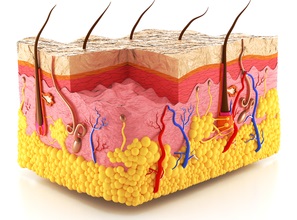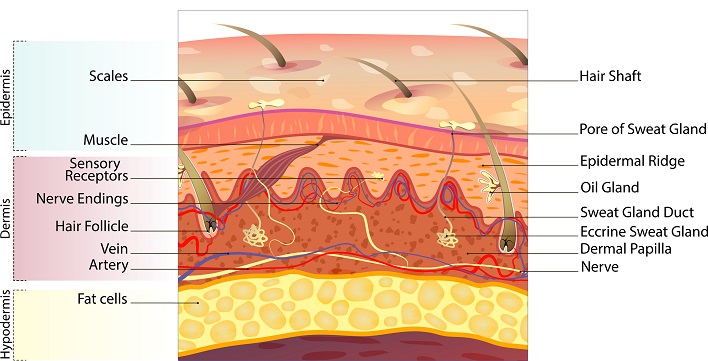The skin is the largest organ in the entire body. It is composed of many layers of tissue and is full of nerve endings, blood vessels and hair follicles. The skin has many different functions, those of which will be explored in this page. Skin cells are constantly being replaced, and it takes around a month for your cells to be totally renewed. The regeneration rate may be faster if the skin becomes damaged.
The Different Layers of Skin
There are 3 main layers of skin, each being comprised of many layers of tissue.
- The outermost layer of skin is called the epidermis.
- The middle layer of skin is called the dermis.
- The deepest layer of skin is called the subcutaneous layer (also known as the hypodermis or the fat layer).
The Epidermis
The epidermis is the outermost of the three layers of skin. It provides a physical barrier between the outside and inside of the body. This is very useful as it means no harmful pathogens can instantly enter the body. It is the epidermis which gives humans the waterproof characteristic. However, the epidermis is also able to hold its own water, keeping the skin healthy and hydrated. Furthermore, the epidermis is where the colour pigments of the skin are held. In humans, the main pigment is called melanin, but other pigments also contribute to skin colour. The epidermis contains no blood vessels and as such, absorbs the oxygen it needs from the air surrounding the skin.
The Dermis
The dermis is the middle layer of skin. It is by far the thickest layer of skin and is comprised of main different cells and organelles. Most of the cells in this layer form connective tissues, and there is an array of blood vessels supplying these cells with oxygenated blood. These connective tissues also helps to protect the body against blunt trauma, by providing a small bit of cushioning. To aid this, nerve endings and other nerve-related cells (such as the Pacinian Corpuscles) reach into the dermis. These detect when something touches the skin, and help to provide the sensation of touch.
The dermis also contains sweat glands. Sweating is one of the systems your body has in place to cool it down. Beads of sweat have the ability to hold a lot of heat energy, meaning when they evaporate off of the body, lots of heat is taken with it.
The Subcutaneous Layer
The lowest layer is the subcutaneous layer, also known as the fat layer. Essentially, this is a very thick layer of fat which helps to insulate the body from both the heat and the cold. The fat serves as a vast supply of energy as it will normally be found close to muscles. It also acts as an even better way of protecting the body from mechanical damage, as these large cells provide a lot of cushioning against trauma.
Damage to the Skin
There are many different ways in which the skin can become damaged. A prominent one which lots of people forget about is sunburn. On very hot days, people may use suncream for protection, yet they forget that sun rays can penetrate cloud. So depending on the intensity of the sun on that particular day, suncream may be required even if the sun isn’t obviously blaring down.
Burns can be very serious, as they are instantly damaging or killing the layers of skin cells. It is imperative that you cool the wound down as fast as possible. Since the epidermis has been broken, the natural barrier to infection has also been broken. This means that harmful pathogens can then enter the body and cause infections and diseases.
Embedded Objects
Objects can become embedded in the skin as well. So this would be a sharp object breaking through and remaining in the body. In cases like these, DO NOT REMOVE the object unless it is really small, such as a splinter. Not only is the object acting as a plug, stopping blood from escaping, but it will also continue to cut the body cells as it is removed. Cuts and grazes may also occur, where the skin has become torn or pierced. This may cause bleeding, and some sort of dressing should be applied. Which dressing you use will be dependant on how big and deep the cut is.
Paper cuts are so painful because instead of rendering the nerve endings in the dermis useless, they only become slightly damaged. This causes frequent nerve impulses to be sent to the brain, and consequently, they are very painful.
For more information on training courses, visit our “Courses” page which also includes our First Responder and First Person on Scene (FPOS) Courses. If you have any queries, don’t hesitate to contact us via our website or call us on 01206 805359.


